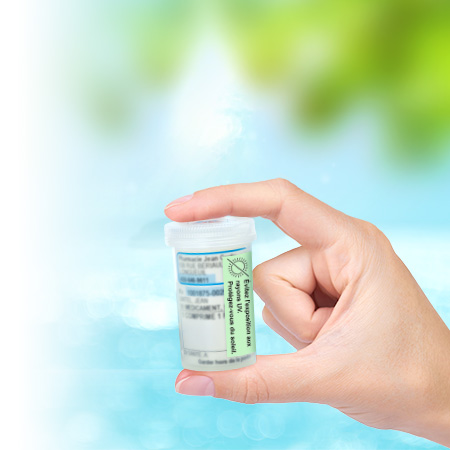The weather is good, the sun is shining, and you're on antibiotics. Everything seems normal, until a rash or a burning sensation appears after a few minutes outdoors. It may be a photosensitivity reaction. It may appear harmless, but it can sometimes be severe, painful and dangerous.
Why are antibiotics and sunlight incompatible?
The sun emits ultraviolet (UV) rays, the best-known of which are UVA and UVB. These rays can damage the skin, causing sunburn, premature aging and even skin cancer in the long term.
But in some people, especially those taking medications such as antibiotics, UVA can trigger an abnormal skin reaction called photosensitivity.
➜ Photosensitivity = medication + sun = skin reaction.
Certain antibiotics, such as tetracyclines, sulfonamides and quinolones, are more often associated with this type of adverse reaction. To enjoy the sun safely, read our article.
What happens during a photosensitivity reaction?
Photosensitivity reactions result from the combined effects of sun exposure and various medications. They may be taken orally, applied to the skin or administered by injection.
Photosensitivity reactions are divided into two types of reaction and are different in cause and effect: phototoxicity and photoallergy.
Phototoxicity: Like a big sunburn
This is the most common reaction. It resembles an intense sunburn, which can appear very quickly (within minutes or hours of exposure).
Symptoms of phototoxicity include :
- Pain;
- Redness;
- Swelling (edema);
- Blisters or vesicles (in severe cases);
- Skin discolouration (brown or bluish-grey).
Why does this happen?
The medication absorbs the sun's energy, transforms it, then releases this energy into skin cells, causing cell damage and inflammation.
Photoallergy: An immune reaction
Less frequent, but also more unpredictable, is photoallergy, an allergic reaction also triggered by the sun after ingestion of an antibiotic. It may appear 24 to 72 hours after exposure and may extend to unexposed areas.
Here are the main symptoms:
- Redness;
- Itching;
- Urticaria;
- Eczema.
Why does this happen?
In short, the sun modifies the chemical structure of the medication in the body. The immune system no longer recognizes this molecule and triggers an allergic reaction.
Is it safe to sunbathe while taking antibiotics?
The answer is simple: Not without precautions. It all depends on the medication. Some are safe, others not. We must not generalize.
Before exposing yourself to the sun, ask yourself the right question: can this medication react with UV rays? Don't forget that your Jean Coutu-affiliated pharmacist can advise you!
What precautions should I take with antibiotics in the sun or in hot weather?
It's always best to avoid areas of high exposure to the sun's UV rays. Here are a few precautionary tips to avoid a photosensitivity reaction:
- Stay in the shade;
- Avoid the hours between 10 a.m. and 4 p.m;
- Wear long clothing, a hat and sunglasses;
- Apply a broad spectrum (UVA/UVB) sunscreen SPF 30 or higher;
- Reapply every two hours and after swimming or perspiring;
If in doubt, it's best to avoid the sun during treatment, and for a few days afterwards. Why? Because some molecules remain in the body for some time after the medication is finished, and the skin remains vulnerable.
See our article for more information on the harmful effects of the sun's ultraviolet rays on your skin.
How long should I stay out of the sun after taking antibiotics?
In general, specialists recommend limiting exposure throughout treatment, and until 48 to 72 hours after the last dose. This may vary depending on the medication.
Which antibiotics are photosensitizing?
It is important to note that not all antibiotics cause photosensitivity. Other types of medication can also make the skin more vulnerable to UV rays.
List of photosensitizing medications to watch out for
- Antibiotics (tetracyclines, quinolones, sulfonamides);
- Nonsteroidal anti-inflammatory medication (NSAID);
- Oral contraceptives or certain hormones;
- Diabetic medications (sulfonylureas);
- Heart medications (amiodarone);
- Acne products (isotretinoin, certain topicals);
- Medications for cancer or psychiatric disorders;
- Personal care products (perfumes, sunscreens with PABA);
Your Jean Coutu-affiliated pharmacist knows which molecules are at risk and can adapt your treatment or advise you on the right protection.
What treatment to apply after an allergy?
In the event of a skin reaction to the sun during treatment, it's important to act quickly to soothe the skin and prevent the situation from worsening. Here are the first steps to take:
- Apply cold compresses;
- Use soothing creams (aloe vera, hydrocortisone if recommended);
- Avoid exposing yourself to the sun again;
Some skin reactions, such as sun hives, summer lucite or pimples after exposure to the sun, can be caused by medications, particularly certain antibiotics. Understanding the symptoms of a sun allergy, recognizing the risks of photosensitivity, and applying the right preventive gestures will help you enjoy the sun safely, even under treatment.
Not sure about your medication for the coming sunny days? Ask your Jean Coutu-affiliated pharmacist, who will be able to advise you on the steps to take and help you choose the right sunscreen or soothing skin care product for your situation.

